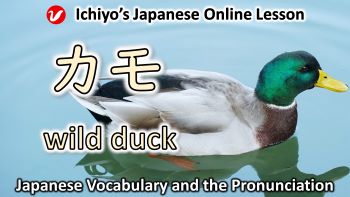The Japanese vocabulary「鴨 (かも、カモ、kamo)」means “wild duck.” Please learn the pronunciation and the example sentences.
Japanese Vocabulary and the Meaning
| Key Word | 鴨、カモ |
| Hiragana | かも |
| Romaji Reading | kamo |
| English Meaning | wild duck |
The Correct Japanese Pronunciations
Please learn the pronunciation by watching the attached video. You can also learn example sentences.
Our main YouTube channel: Ichiyo’s Japanese YouTube Channel
Our sub-YouTube channel (Japanese vocabulary videos): Ichiyo’s Subchannel
The Example Japanese Sentences
It is important to have skills in both non-honorific and honorific languages in order to use Japanese correctly.
This is a duck-shaped boat.
Plain Form:
これはカモ型のボートだ。
Kore wa kamo-gata no bōtoda.
Polite Form:
これはカモ型のボートです。
Kore wa kamo-gata no bōtodesu.
I cooked a wild duck hotpot.
Plain Form:
鴨鍋を作った。
Kamo-nabe o tsukutta.
Polite Form:
鴨鍋を作りました。
Kamo-nabe o tsukurimashita.
I took a photo of a wild duck.
Plain Form:
鴨の写真を撮った。
Kamo no shashin o totta.
Polite Form:
鴨の写真を撮りました。
Kamo no shashin o torimashita.
Wild ducks are migratory birds.
Plain Form:
カモは、渡り鳥だ。
Kamo wa, wataridori da.
Polite Form:
カモは、渡り鳥です。
Kamo wa, wataridori desu.
Wild ducks migrate to Hoppo around April to May.
Plain Form:
カモは4月から5月頃に北方へ渡る。
Kamo wa shigatsu kara gogatsu goro ni hoppō e wataru.
Polite Form:
カモは4月から5月頃に北方へ渡ります。
Kamo wa shigatsu kara gogatsu goro ni hoppō e watarimasu.



